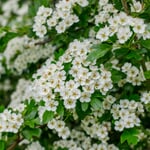Native woody plant Invasive hawthorn

General Information
Flower: From May to June, the shrub is covered with small white flower umbels that provide pollen and nectar for over 40 species of wild bees and some butterflies.
Fruit: From September, the elongated dark red fruits, which look like small apples, ripen. They remain on the branches well into the winter and thus serve as valuable winter food for over 40 bird species and various small mammals. They are also edible for humans and can be processed into jelly, compote or sauces.
Plant: The hawthorn grows to a height of 3-5 m and a width of 5-6 m with a broad spreading habit. The dense shrub with its thorny branches can be used to create impenetrable hedges, but is also an excellent bird protection shrub as a solitary plant. The hawthorn foliage is particularly valuable for butterflies: it serves as food for the caterpillars of almost 80 species, five of which are specialized on this plant and need it for their survival.
Site and climate requirements: The plant is robust, easy to care for, tolerates drought and heat well and is very hardy. The only thing to note is that the soil must not be acidic and, if relevant at the edge of the plot, must not be contaminated with road salt. Otherwise, all soils in sun and partial shade are suitable.
Rating particularly (ecologically) valuable. Native plants
The value of a plant, apart from a monetary consideration, is determined by various functions. Plants produce oxygen, regulate the climate, protect the soil, provide us with food, fibers and other raw materials - and they form the basis of ecosystems that are all the more stable the more diverse they are. Plants provide habitats for countless organisms and promote biodiversity in a broad sense. In terms of this criterion, our native plants are far superior to so-called neophytes, i.e. plant species originating from other areas, as they safeguard the relationships and dependencies between flora and fauna that have developed in this country over thousands of years.
Well-established teams. From plants and animals
The closest relationships are between plants and insects. This goes so far that some insects live on just one plant species. If this is not present, for example because its habitat has been destroyed or it has been displaced by invasive neophytes, the insects that depend on it also die out - an observation that is as fascinating as it is tragic. This dependence can often be recognized by the name of the animals. The common viper's bugloss mason bee, for example, lives solely on the native common viper's bugloss, which also provides food for almost 40 other species of wild bees and butterflies.
But it is not only the flowers with their nectar and pollen supply that ensure the survival of insects, the stems and leaves of the plants are almost even more important, as they are used to build nests and are eaten by butterfly caterpillars, leaf wasp larvae and beetles. Over 90% of all herbivorous insects specialize in their food plants! This shows how important it is to have the most species-rich and ecologically valuable planting possible. Birds and small mammals such as dormice, dormice and squirrels feed on the seeds, berries, nuts and other fruits of plants. Their presence ensures the survival of the animals, especially in the cold season.
From a simple garden to an ecological hotspot
In the open countryside, many habitats are almost non-existent; for example, the dry, nutrient-poor sites with their very own flora or occasionally flooded, wet meadows. The use of pesticides or the progressive sealing and impoverishment of the landscape makes it difficult for plants and animals to find sufficient habitat and food. However, our gardens have great potential to at least counteract this and, by choosing the right (native) plants, can provide valuable biotopes and last refuges for animal species that have already become extremely rare, such as numerous butterflies that could be observed almost everywhere around 40 years ago.
Native woody plants: Flowers, leaves and fruit for countless animals
In addition to our existing range of native plants in the areas of perennials, roses, flowers and flower bulbs, we now also offer selected native woody plants. Some of these are already endangered species themselves, such as the shrub crown vetch, or contribute to the survival of many of our garden animals, such as the buckthorn, which is the main food plant for the caterpillar of the now rare lemon butterfly.
Product Information
Article Number 215533
Also known as hawthorn, the hawthorn belongs to the rose family and can be found wild throughout Central Europe: in sunny bushes, along paths and forest edges as well as in mixed deciduous forests. Its ecological value for our native fauna is immense, as the flowers, leaves and fruits feed no fewer than 180 different animal species. With its deep roots, the plant is well equipped to withstand periods of drought. Biennial shrub, with 3-4 shoots, bare root. Height on delivery 60-80 cm.
We ship from the beginning of February to the end of November. Please note that the planting season may be delayed or shortened due to weather conditions.
If you have a question concerning this product you are welcome to contact us. For this your E-Mail program will open.
Customer Service
Ob Beratung, Ersatzteile oder Sonderwünsche - all Ihre Fragen und Anliegen behandelt unser Customer Service persönlich und fundiert.
Sie erreichen uns von Montag bis Freitag unter der Nummer +49 2309 939095 oder jederzeit unter info@manufactum.de
Das Gartenjahr
Egal ob großer Garten oder kleiner Balkon – Antworten auf alle Fragen der Gartenarbeit finden Sie im Manufactum Gartenjahr. Nach Gartentyp und Jahreslauf gegliedert werden alle wichtigen Arbeiten leicht verständlich und Schritt für Schritt beschrieben.
Zum Gartenjahr


